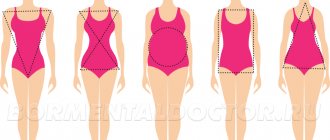However, depending on your activity level, body size, and goals, you may need more.
This article discusses everything you need to know about the 3,000-calorie-a-day diet, including reasons for doing it, what foods to eat and limit, and a sample meal plan.
Nutrition for gaining muscle mass - menu to choose from for girls and men
Anyone who decides to gain muscle mass first needs to determine their daily calorie needs.
To do this, use an online calculator or calculate your basal metabolism using the Mifflin San Geor formula:
For example, let’s take a 25-year-old athlete, 170 cm tall, with an initial weight of 75 kg. His daily calorie requirement will be as follows: 10x 75 + 6.25x 170 - 5x 25 +5 = 1682 Kcal
This is the number of calories needed for the body to function. Coefficients are also provided to take into account the level of physical activity:
- Low activity or sedentary work - 1.2
- Light activity (1-3 workouts per week) – 1,275
- Medium activity (3-5 workouts) – 1,55
- Increased activity (5-7 workouts) – 1.725
- Heavy physical work or several workouts a day – 1.9
Let's assume that our athlete or sportswoman trains 4 times a week, based on this, we multiply the daily requirement by the required coefficient: 1682 x 1.55 = 2607 Kcal - This is the number of calories required to maintain the current weight.
Calculation of the amount of nutrients
Now it’s a small matter; we add 15-20% to the resulting figure. How much percentage you should add depends on the rate of weight gain:
- if quite quickly - 15%,
- if slowly and with difficulty - 20%.
In our version, this will be the average, so 2607 + 17% = 3050 Kcal. We have arrived at the calorie content required for an athlete to gain weight.
Having calculated your calorie intake, it is important to determine which nutrients and in what quantities should be consumed. For high-quality weight gain, the nutritional proportions are as follows:
For this calculation, we take into account that from 1 gram of protein and carbohydrate we get 4 calories, and from 1 gram of fat we get 9 calories. In this example, we take the proportion 30/15/55 and get:
- 3050 x 0.3 = 915 Kcal (from proteins)
- 3050 x 0.15 = 458 Kcal (from fat)
- 3050 x 0.55 = 1678 Kcal (from carbohydrates)
The last thing to do is to calculate the amount of nutrients in grams:
- 915:4=229 g protein
- 458:9=51 g fat
- 1678:4=419 g carbohydrates
As a result, we find that in order to increase muscle mass, an athlete needs to consume 3050 kcal, of which 229 grams of protein, 51 grams of fat and 419 carbohydrates.
May Help You Gain Weight
While many people strive to lose weight, others strive to gain weight.
Weight gain occurs when you consistently consume more calories than you burn each day. Depending on your level of physical activity and body size, 3,000 calories may be more than your current caloric needs, causing you to gain weight ().
Why You May Want to Gain Weight
There are several reasons to want to gain weight.
If your body mass index (BMI) classifies you as underweight, your doctor or dietitian may recommend that you gain weight.
Alternatively, if you're an athlete, you can gain weight - ideally in the form of muscle mass - to perform better in your sport.
Likewise, if you are a bodybuilder or powerlifter, you may want to gain weight to increase muscle size and strength.
In other cases, you may have a medical condition that increases your caloric needs, such as cancer or infection, or you may be recovering from major surgery (,).
Safe rate of weight gain
While research on this topic is sparse, an acceptable rate of weight gain is 0.2–0.9 kg per week ().
However, in people with severe malnutrition, weight gain of approximately 2 kg per week is considered safe ().
Rapid weight gain can lead to unpleasant side effects such as bloating, stomach upset, and fluid retention. If you are an athlete, these side effects may impair your performance by negatively impacting your training ().
Moreover, rapid weight gain can increase triglyceride levels, which may increase the risk of developing cardiovascular disease (, ).
How quickly you gain weight depends on how many calories you need to maintain your weight.
If you maintain your weight by eating 2,000 calories a day, you will gain weight much faster on a 3,000-calorie diet than someone who maintains their weight by eating 2,500 calories a day.
For example, one 8-week study found that when 25 healthy people ate an extra 950 calories above their weight maintenance calorie needs, they gained an average of 5.3 kg, 3.5 kg of which was fat ().
If the same participants ate just 500 calories more than their calorie needs over the same duration, they would likely gain much less weight.
Summary:
For some people, 3,000 calories may help them gain weight. An acceptable, safe rate of weight gain is 0.2–0.9 kg per week.
Nutrition menu for weight gain
An approximate menu for 3000 Kcal could be like this:
Option 1
Breakfast:
- Oatmeal with milk – 100 g dry
- Milk (1.5%) – 200 ml
- Boiled eggs (2 whites + 1 whole) – 3 pcs.
- Whole grain toast
Lunch:
- Banana – 1 piece
- Bun with poppy seeds – 1 piece
Dinner :
- White rice – 100 g dry
- Chicken breast – 1/2 pcs
- Seasonal vegetables – 100 g
- Whole grain bread (1 piece)
Afternoon snack:
- Rice - 100 gr
- Chicken breast - 1/2 pcs
- Seasonal vegetables - 100 g
Dinner:
- Pollock – 200 gr
- Potatoes – 150 gr
- Vegetable salad with sour cream – 150 g
Last meal:
- Low-fat cottage cheese – 150 g
- Kefir 1% – 150 ml
Option 2
Breakfast:
- Buckwheat porridge – 100 g dry
- Omelette of 1 egg and 2 whites
- Milk (1.5%) – 50 ml
- Whole grain toast
- Hard cheese – 30 g
Lunch:
- Apple – 1 pc.
- Dried apricots – 100 gr
Dinner:
- Wheat porridge – 100 g dry
- Turkey fillet 200 gr
- Vinaigrette – 100 gr
- Cereal bread (1 piece)
Afternoon snack:
- Wheat porridge – 100 g
- Turkey fillet – 200 gr
- Vinaigrette – 100 gr
Dinner:
- Hake – 200 gr
- Green beans – 100 gr
- Vegetable salad with sour cream – 150 g
- Last meal:
- Low-fat cottage cheese – 150 g
Option 3
Breakfast:
- Corn porridge with milk – 100 g dry
- Milk (1.5%) – 200 ml
- Fried egg made from 1 egg and 2 whites
- Whole grain toast
- Butter – 1 tsp.
Lunch:
- Pear - 1 piece
- Nuts (walnuts, peanuts, almonds) – 30 g
- Marshmallow (marmalade) – 100 g
Dinner:
- Pearl barley porridge – 100 g dry
- Beef goulash – 200 gr
- Vegetable salad – 150 gr
- Rye bread (1 piece)
Afternoon snack:
- Pearl barley porridge – 100 g
- Beef goulash – 200 gr
- Vegetable salad – 150 gr
Dinner:
- Chicken breast – 1/2 pcs
- Canned vegetables – 150 gr
- Rice – 100 g
Last meal:
- Low-fat cottage cheese -150 gr
- Ryazhenka – 1 glass
This is a sample menu from which you can build your own. The main thing is to adhere to the norm of proteins, fats and carbohydrates, and observe calorie content. You should not overeat, as the gain of fat mass increases, which grows with mass gain. The last meal is casein, a long-lasting protein. It is found mainly in cottage cheese and will help nourish muscles during sleep.
Permitted and prohibited products
A high-calorie diet requires the inclusion in the menu of foods that have high energy value and contain sufficient amounts of vitamins, minerals and other beneficial substances for the body.
Recommended ones include:
- fish;
- turkey;
- chicken;
- pork;
- mutton;
- veal;
- rice;
- buckwheat;
- quinoa;
- pasta;
- quail and chicken eggs;
- whole wheat bread;
- cottage cheese;
- milk;
- Greek yogurt;
- kefir;
- chickpeas;
- peas;
- tofu;
- walnuts;
- almond;
- flax seeds;
- nut butters;
- olive oil;
- berries;
- avocado;
- bananas;
- pears;
- grape;
- apples;
- oranges;
- sweet potato;
- pumpkin;
- broccoli;
- zucchini;
- pepper;
- tomatoes;
- butter
- marshmallows;
- marmalade;
- Ryazhenka
- cauliflower, etc.
Among other things, casein and whey protein powders are allowed into the diet, which can be added to cocktails and smoothies.
It is necessary to exclude from the diet high-calorie foods that contain few nutrients. You should avoid eating fried foods. In addition, you should not eat fast food. You need to stop consuming sugary drinks and foods. All products containing refined carbohydrates are prohibited, including sweet cereals, cookies, chips, etc.
How to eat to gain muscle mass
It is important not to skip meals and not to fast for more than 3 hours.
The ideal nutrition option for a man to gain muscle mass would be to eat according to the clock, so the body will quickly adapt to the system and itself will give a signal that it is time to eat. On average, the body's adjustment to a new regime takes about 3-4 weeks. Another secret to maintaining a routine is planning your meals in advance. At first you will have to weigh everything and keep a food diary, but over time this will no longer be necessary. There are special services for this on the Internet, or you can install applications on your phone.
For those who have not exercised before and have decided to gain weight, increasing physical activity within reasonable limits has a beneficial effect on appetite and nutrient absorption. Therefore, to accelerate weight gain, you need to use the muscles of the body. A set of exercises for boys and girls at home and in the gym. And for those who are especially thin, it’s worth reading this article.
When starting the period of weight gain, a list of necessary products is compiled and purchased for the first week. It’s better to create a menu and prepare food for the whole day at once; this will help you distribute food correctly, so that you don’t add calories at the last moment with anything.
The time to gain weight takes different amounts of time for everyone, so you should clearly define the result.
It is better to increase the calorie content and volume of food gradually, this way you can avoid discomfort and confidently move towards your goal. There is no need to rush in this matter, as they say, .
” Listen to your body and you will soon see positive changes. The most difficult thing about organizing meals is maintaining the timing and number of meals. It's always easier to sit down at the table once a day and eat to your heart's content. When everything happens randomly, the result may not be pleasing at all. Been through this before. And when I decided to start gaining weight more closely and began to follow all the rules, after about a month I began to notice an improvement.
Ways to maintain a proper diet
Calories enter the human body from fats, carbohydrates and proteins. It is extremely important that all these components are present in the diet. It should be noted that 1 g of protein contains only 4 kcal, 1 g of fat - 9, and 1 g of carbohydrates - 4 kcal. It is necessary to distribute them correctly. Food should be consumed 5 times a day. In this case, carbohydrates should be eaten in the first half of the day, and fats and proteins in the second.
It is not necessary to make large portions. The following ratio is recommended:
- carbohydrates - 45-65%;
- proteins - 10-35%;
- fats - 20-35%.
This meal plan does not involve fasting. It is necessary to consume 338-488 g of carbohydrates, 75-263 g of proteins, 67-117 g of fats. However, such a high calorie content requires increased physical activity, because Without this, the diet will lead to a gain of fat mass, not muscle mass.
In addition, people who want to increase their weight without harming their health need to have the right approach to choosing foods and preparing them. It is better to prepare dishes by steaming, boiling or stewing. This will help retain nutrients in them.
Products that do not require mandatory heat treatment are preferably consumed fresh.
How to eat on 2000 calories

The Food and Drug Administration considers the daily value of calories to be 2,000, which is the amount of nutrients most people need. So what does a 2,000 calorie diet look like?
Fruits and vegetables
If you're aiming to eat 2,000 calories a day, you'll need: 2 cups fruit, 2 1/2 cups vegetables.
What the daily norm might look like:
- 1 medium apple
- + 1 cup berries
- + 12 carrots
- + 1 cup cooked vegetables
Grains
If you're aiming to eat 2,000 calories a day, you'll need: 6 ounces of grain equivalents (1 ounce = 28 g).
What the daily norm might look like:
- 1 English muffin
- + 12 cm flatbread
- + 1 slice of bread
- + 1 cup rice
Low-fat dairy products
If you're aiming to eat 2,000 calories a day, you'll need: 3 cups of nonfat dairy.
What the daily norm might look like:
- 1 cup milk or soy milk
- + 1 glass of kefir
- + 1/3 cup grated cheese
Protein
If you're aiming to eat 2,000 calories a day, you'll need: 5 1/2 ounces equivalents.
What the daily norm might look like:
- 85g cooked salmon, chicken or beef
- + 12 pcs. almonds
- + 1/4 cup cooked beans
Trans fats and sugar
Ideally, give up sugar. But if you find it difficult to do this, stick to the daily limit recommended by experts. If you're aiming to eat 2,000 calories a day, you'll need: No more than 258 calories of these foods.
What the daily norm might look like:
- 60 g sweet bar or glazed donut
Oils and salt
If you're aiming to eat 2000 calories a day, you'll need: 27g butter and 2300mg salt.
What the daily norm might look like:
- 5 1/2 tsp. oils
- 1 tsp. table salt
The essence of the diet
Sports and a healthy lifestyle sometimes do not bring positive results in gaining muscle mass. Sports supplements and anabolic steroids cause irreparable harm to health. The 2500 calorie per day diet is a sports nutrition diet aimed at accelerating the process of positive athletic performance.
The diet was optimized for athletes, but has now gained popularity among those who want to balance their diet. The basis of 2500 calorie sports nutrition is protein.
Benefits of dietary nutrition:
- Price;
- No load on the digestive tract;
- Consumption of nutrients and vitamins;
- Clear power characteristics;
- Ease of use.
The 2500 calorie per day diet is suitable not only for sports enthusiasts, but also for patients with diabetes, with the addition of glucose-lowering oral medications to the diet.
How to eat on 3000 calories
If you're looking to get down to 3,000 calories a day, chances are you're underweight or trying to gain muscle mass. Active adult men ages 19 to 35 need 3,000 calories per day to maintain a healthy body weight, according to dietary recommendations.
Eat frequently—every few hours—and choose nutritious, high-calorie foods.
3000 calorie meal plan
- 4 cups vegetables
- 2.5 cups fruit
- 200 g protein products
- 280 g grains
- 3 cups dairy products
- 10 teaspoons oil
- 459 additional calories from foods of your choice
Protein
If you're aiming to eat 3,000 calories a day, you'll need: 200 grams of protein foods (eggs, lean meats, poultry, seafood and soy products).
What does one serving look like (=28 g):
- One egg
- 1.5 egg whites
- 28 g meat, fish or poultry
- 14 g nuts or seeds
- 1 tbsp. l. nut butter
- one quarter cup of legumes
- half a veggie hamburger or a quarter cup of tofu
Dairy
If you're aiming to eat 3,000 calories a day, you'll need: 3 cups of dairy.
What does one serving look like:
- 1 cup milk, yogurt or soy milk
- 2 cups cottage cheese or 42 g hard cheese
Grains
If you're aiming to eat 3,000 calories a day, you'll need: 280 grams of grain.
What does one serving look like (=28 g):
- One slice of bread
- 1 cup ready-to-eat grains or 1/2 cup cooked rice, pasta, or oatmeal
Fruits
If you're aiming to eat 3,000 calories a day, you'll need: 2.5 cups of fruit.
What does one serving (1 cup) look like:
- 1 cup fruit juice
- 1 cup fresh fruit or 1/2 cup dried fruit
Vegetables
If you're aiming to eat 3,000 calories a day, you'll need: 4 cups of fruit.
What does one serving (1 cup) look like:
- Cup of raw or cooked vegetables
- 2 cups leafy greens or 1 cup vegetable juice
Oils
If you're aiming to eat 3,000 calories a day, you'll need: 10 teaspoons of oil.
What does one serving (1 teaspoon of a group of oils) look like:
- 1 tsp. vegetable oil
- 1 tbsp. l. Italian salad dressing
- 1.5 tsp. nut butter or 9 g nuts (or seeds)
Sample menu
Breakfast
- two slices of whole grain toast with 1 tbsp. l. peanut butter
- 1 cup yogurt
- Two eggs
- 1/2 cup oatmeal
- 1 cup fresh strawberries
Morning snack
- 28 g almonds
- 1 cup fresh blueberries
Dinner
- 85 g grilled chicken breast
- 2 cups leafy greens
- 1/2 cup chopped cucumbers
- 1/2 cup cherry tomatoes
- 2 tbsp. l. Italian salad dressing
- 1 cup brown rice
Afternoon snack
- 1 cup low sodium vegetable juice
- 85 g low-fat cheese
- 1/4 cup raisins
- 10 whole grain crackers
Dinner
- 85 g grilled salmon
- 1 cup steamed broccoli
- 1 cup whole wheat pasta with 1 tbsp. olive oil pesto sauce
Evening snack
- 3 cups popcorn
- 1 cup kefir
- 28 g peanuts
Protein Shake Recipes
Cocktail of oranges and bananas
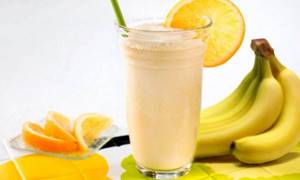
Ingredients:
- orange juice concentrate (250 ml);
- vanilla low-fat yogurt (100 g);
- banana (1 pc);
- six ice cubes;
- milk 1% fat (100 g).
Place all ingredients from the recipe in a blender and blend.
Cocoa cocktail
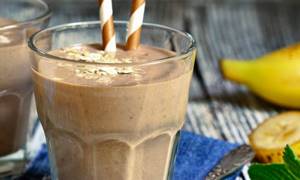
Ingredients:
- kefir (500 ml);
- cottage cheese (300 g);
- natural cocoa powder without additives (5 tsp);
- water (100 ml);
- sweetener.
How to cook:
- Dilute cocoa powder and sweetener with water, put on fire and bring to a boil;
- Cook for a minute, stirring, then cool. Add the chocolate mixture to the cottage cheese and kefir mixture and beat until smooth;
- Drink chilled.
Soy Protein Shake with Almonds
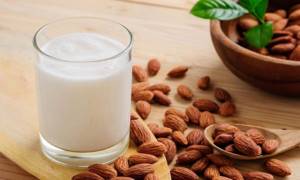
Ingredients:
- protein (1 scoop);
- soy milk (1 tbsp);
- crushed almonds (1 tsp);
- maple syrup without sugar (1 tsp);
- vanilla extract (3 drops);
- ice;
- Greek yogurt (1 tbsp.)
Mix all the ingredients of the cocktail and blend in a blender.
How to eat on 4000 calories
The 4,000 calorie per day diet is suitable for young and active people or underweight people who are trying to gain weight for health. While it may be tempting to eat calorie-dense junk food to fill 4,000 calories, eating this way can lead to health problems. Therefore, we advise you to aim for a healthy, balanced diet.
Divide 4,000 calories into six separate meals, each containing 600 to 850 calories. Eat every three to four hours and have a snack, such as a peanut butter or meat-and-cheese sandwich, before bed.
Breakfast (about 820 calories)
- Cup of oatmeal (with low-fat milk, banana and peanut butter)
Nutrition for muscle growth
The mistake many beginners make is that they want everything at once. They want their muscles to immediately grow in relief, and the amount of fat to constantly decrease. So, I’ll say right away that this is impossible. These are completely different training and nutrition programs.
By trying to practice according to a universal scheme, you simply delay the result that is significant for you.
To start gaining weight, you have to spend a lot of calories, but you need to get even more, and in order to lose excess weight and work on relief, you need, on the contrary, to “undereat”.
How much and what should you eat?
Each person is unique and each person needs a certain number of calories per day. You can calculate the required number of calories here. The average person needs to eat approximately 2500 – 3000 calories per day. Not so little.
Professionals note that guaranteed muscle growth begins when the number of calories consumed per day exceeds the norm by 500 - 1000 calories.
That is, if you need to eat 3,000 calories a day to maintain body processes, then muscles will begin to grow when you consume 3,500 - 4,000 calories. To obtain this amount of calories, you need to consume a significant amount of food.
Important!
Nutrition for muscle growth is a lot of calories from carbohydrates, so that there is energy for muscle recovery, a large amount of proteins, so that the muscles have something to build from, but you shouldn’t forget about fats either.
Many people are very afraid to eat fatty or low-protein foods. They think they will only get fat and therefore don't eat enough. This is a very common mistake for beginners. Of course, you shouldn’t eat fatty foods on purpose, but this is not a reason not to eat at all.
As Robbie Robinson said, when he began his training as a teenager, he began to eat huge amounts of protein and carbohydrates and did not even think about how much fat he ate. Over the course of a year of training, he gained about 20 kg of weight. Of course, it was not purely muscle, the percentage of fat was quite high.
But this is normal, this is how it should be, otherwise you are just making things more difficult for yourself. Today, when novice bodybuilders come to the gym, they immediately try to work on the relief and consume few carbohydrates, as a result, the energy runs out, there are no results and many give up this business altogether, citing their unsuccessful genetics.
Remember: for muscle growth to begin, you need to overdo it with calories, which are best obtained from complex carbohydrates.
One of the steps to a beautiful body is gaining weight. It doesn't matter how much fat you gain along with muscle. As soon as you gain enough weight, you will begin to work on the relief and lose excess fat.
Muscles cannot work in two modes at once, increase strength, volume and improve endurance, because for different modes they change their structure and principle of operation.
For this reason, we conditionally divide athletes into track and field athletes and weightlifters.
Eat as often as possible
Try to fuel your body as often as possible. This lets your body know that food is always available and it doesn’t need to store fat. Try to eat at least every 2-3 hours. Don't overeat, try to eat as much as you need.
Learn to listen to your body, don’t force food into your stomach. Maybe he's just not ready to accept that much food yet. When you start burning calories consistently, your appetite will appear.
Advice!
Over time, your body will get used to it and will constantly ask for food and, moreover, in large quantities. It will come, in time.
Breakfast, second breakfast, lunch, afternoon snack and dinner - this is the normal diet. After training, you can also drink a protein shake at night depending on how you feel.
Try to shift your carbohydrate intake to the morning and protein intake to the evening. In the morning and at lunchtime, you shouldn’t be afraid of fatty foods; it’s better not to overeat at dinner.
You should not skip meals in the morning, afternoon and evening.
Try to eat more for breakfast, even if at first it seems like you don't want to eat. Breakfast is a very important part of nutrition. It gives you a boost of energy for the whole day.
Eat before bed. If you are about to sleep, eat yogurt, banana, apple. Fruits are good to take in the evening.
I advise you to definitely eat something before going to bed, even if it’s not a big one. Many people, for example, mix cottage cheese with milk and drink it.
This will allow your stomach to work for several hours, and you will reduce your body's morning hunger. While you rest, your muscles will have something to grow from. But this advice is definitely about how you feel.
Many people do not sleep well when they eat at night; this is a matter of habit. For example, I don't have any problems.
What to do if you can’t eat enough at work, at school, or on the road
Such cases also include insufficient stomach capacity. In such cases, it is recommended to use special protein (protein) or carbohydrate (gainer) cocktails. They will allow you to “get” the missing calories for the day.
Products that are recommended to have in the daily diet
Cottage cheese (Better 0.3%)
Milk (preferably skimmed 0.5-1.5%)
Fish (Proteins + carbohydrates + vitamins)
Nuts (Proteins and Carbohydrates)
Bananas (carbs + B vitamins + minerals)
Rice (Carbohydrates. Good for breakfast and lunch, as a side dish)
Porridge, preferably oatmeal (Also high in carbohydrates + vitamins and minerals + fiber. Great for breakfast)
Chicken (High protein, especially low-fat breast)
Vegetables and fruits must be present in the daily diet (various vitamins)
I advise you not to exclude meat and dairy from your diet, since “milk” and “meat” protein are absorbed differently and are certainly needed by your body to gain muscle mass.
Source: https://musclefactory.ru/pitanie-na-nabor-massy.html
How to create a menu for 3000 calories a day?
It is especially important for athletes to eat properly and have enough calories. In order for athletes to eat 3,000 calories a day, the menu must be prepared with special diligence and special care.
Let's see what a 3,000 calorie per day menu might look like. How to properly structure your diet so that this diet works in the right direction for many days?
To begin with, it is important to understand what the basic principles of any nutrition plan are.
There is such a thing as BZHU (proteins, fats, carbohydrates) and calorie content. We should focus on them when creating a diet.
- 1. Calorie content. It depends numerically on goals and weight, as well as lifestyle and metabolic rate. For example, for a person weighing 100 kg, but leading a predominantly sedentary lifestyle, this is one value, but for a person who consistently trains 3-4 times a week in the gym, it is completely different. The difference in nutrition between these two people can be up to 500 kcal/day, which is a very impressive figure. There are special calculators that allow you to calculate the optimal caloric intake depending on your lifestyle.
- 2. Proteins. Protein is the main building material for our body. It is thanks to him that we get the opportunity to build new muscles. It is important to understand that there should not be too much protein in an athlete’s diet and there should not be too little. The optimal dosage for an athlete gaining weight is from 2.5 to 3.5 grams per kilogram of weight. For an athlete who is cutting (losing weight), from 2 to 2.5 grams per kilogram of body.
- 3. Carbohydrates. Carbohydrates are the main fuel that the body, unlike fats, tries not to accumulate, but to immediately use. But in case of an excess of these nutrients, they can be deposited on the sides. It is believed that the optimal dosage for an athlete gaining weight is from 3 to 6 grams per kilogram of weight. For athletes who are cutting, from 2.5 to 3.5 grams per kilogram of weight.
- 4. Fats. Fats are our body's reserve reserves. They must be in the diet, because if they are deficient, problems with vision and the endocrine system begin. But there should be few of them. The optimal dosage will be considered no more than one gram per day.
So, above we described the basic principles of calculating BJU and calorie content to create a balanced nutrition plan for a training athlete.

Now about how to create a menu for 3000 calories a day.
- 1. We start by calculating the minimum package of BZHU. Let’s take an athlete weighing 120 kg as a guide (the calorie content is calculated for approximately such an athlete). This means that he will need at least 240 grams of protein per day, carbohydrates - 360 grams per day, fats - no more than 120 grams per day. These indicators should be obtained by summing up the nutritional value of all foods eaten per day.
- 2. We start with scheduling meals. For breakfast, porridge, for example, oatmeal with water. Per 100 grams of this product there will be about 3 grams of protein, 15 grams of carbohydrates, 1.7 grams of fat. If a person eats 300 grams of such porridge, it means that for the first meal he receives about 45 grams of carbohydrates, 9 grams of proteins and 5 grams of fats. If you eat porridge with a banana, this will add 24 grams of carbohydrates and 2 grams of proteins. That is, in total at breakfast there are about 60 grams of carbohydrates, 5 grams of fats and 11 grams of proteins. Then a snack in the form of 200 grams of low-fat cottage cheese, that is, about 30 grams of protein. And so on. The algorithm is simple - the main thing is not to miscalculate!
- 3. It is important to keep within the calorie limits of 3000 kcal, proteins 240 g, carbohydrates 360 g, fats - no more than 120 g. If somewhere in the diet there is a shortage or excess of nutrients, then this must be corrected. Balance is the key word in this matter!
That's the whole fairly simple algorithm for creating a balanced nutrition plan for athletes and, in general, for all people leading an active lifestyle. Look after yourself and don't stop there!
My diet: how to gain weight
I am often asked how I eat when I reduce body fat. However, the question of how to gain muscle mass also comes up quite regularly.
At the end of July 2013, after filming the new Hollywood film “Black Rose”, I decided to recalculate my own nutrition, since I had not trained for more than a month, ate everything in a disorderly manner and my weight was 91 kg (before filming began it was 89).
When I had the time and energy to calculate my daily caloric intake, I got 3000-3500 kcal.
However, time moved on and it was time to develop a plan on how to gain muscle mass by combining a balanced diet and regular strength training. At the same time, I would like to gradually reduce the “muscle/fat” ratio by building muscle while maintaining (or even reducing!) the fat layer.
Below is my nutrition program for gaining weight. And, if I increased the intensity of training gradually, then I introduced dietary restrictions into the daily diet almost immediately in full.
Attention!
And so I started! On the fifth day after starting training and the following diet, my weight was 91.3 kg with 17.3% fat (according to InBody 720 readings). After 5 days, the weight dropped to 90.2 kg (I guess the body had to adapt), and after 15 days the scales showed 91.7 kg.
To clearly understand how to gain weight, I calculated the required ratio of nutrients for my own weight of 91 kg. I got the following:
- Calorie intake 3000-3410 kcal/day
- Carbohydrates 319-458 grams per day
- Protein 165-249 grams per day
- Fats 44-91 grams per day.
At the same time, my main metabolic rate according to the Harris-Benedict formula is 1916 kcal (“InBody 720” claims 2001 kcal).
Having previous experience and understanding how to gain weight, I carefully recorded my daily diet for 15 days. I used the following products: Bananas (90-280 g), Imunele (100 g), Myllyn Paras oatmeal (120 g),
oat flakes “Nordic” (120-140 g), buckwheat “Don Gusto” (100-200 g), Dr. bread.
Korner buckwheat (10-100 g), Dymatize Elite Mass (80-169 g), steamed salmon (160 g), chicken fillet “Troekurovo” (188-398 g), chicken fillet “Petelinka” (233-466 g) , Petelinka breast (600 g), Multipower Protein Shake 55g (1 piece), Muscle Milk (414 ml), QNT Delicious Protein (35 g), Amber cheese 10% (140-200 g), Diplomat cheese "(132 g), cheese "Hollender Light" 17% (55-275 g), cottage cheese 1.8% (180-360 g), pasta "Makfa" (250 g), rye bread "Bavarian" (220-300 g), cappuccino (350-900 ml), selected dried apricots “Baraka” (18-97 g), Dr. Korner “cranberry” bread (30-100 g), boiled rice (50-194 g), baked salmon (140 -145 g), steamed vegetables (100 g), Healthy English Breakfast bread (10-20 g), Espirit Noir 85% chocolate (40 g), Espirit Noir 76% Orange chocolate (50 g ), chocolate “Apriori assorted” (20 g), cottage cheese casserole (80-100 g), steamed chicken dumplings (350 g), “Diet” sausage (220 g), fish soup (250 ml), Philadelphia roll ( 150-180 g), chicken kebab (50 g), salmon kebab (50 g), pancakes with salmon (120-200 g), chocolate milkshake (300 g), fresh-cooked salmon (40-140 g), carbonade (10 g), cognac cervelat (75 g), Mozzarella cheese 42% (180 g).
Source: https://dyakonov.ru/?p=4210
3500 calorie diet
Delicious dishes that can be prepared for future use.
Cold oatmeal, cutlets, meatballs, lasagna or stuffed peppers can be prepared for future use. The side dish “lives” in the refrigerator for a day, the sauce lasts for two days, eat the salad fresh, but you must cover it with a lid and under no circumstances leave a spoon inside.
It is better to buy bananas on the weekend and slightly unripe, so that they can be preserved until Friday and always be at hand. Don't be afraid of butter and full-fat milk, you're not a dry bikini, after all.
Cold oatmeal with fruits, berries and seeds
Yes, there is an error in the recipe: pumpkin seeds are called cardamom. Sorry.
Ingredients for four servings:
- 360 g oat flakes
- juice from 4 oranges
- 160 ml water
- 20 g pumpkin seeds
- 10 g sunflower seeds
- 20 g raisins
- 2 apricots
- 40 g blueberries
- 4 strawberries
- 4 spoons of natural yogurt
Take the largest oatmeal flakes, the least processed ones, that is, those that require cooking - they have more fiber and vitamins.
In the evening, put the flakes in a blender and squeeze the oranges into them (if the pulp gets in, it's okay - it tastes better), and then blend for 30-50 seconds. In a separate bowl, mix pumpkin seeds, sunflower seeds and raisins, cover them with water. Close the container with ground oatmeal tightly with a lid, and it would be better to cover the seeds and raisins with something. Place both bowls in the refrigerator and forget about them until the morning.
In the morning, place the oatmeal mixture on plates, add seeds and raisins to it, and then decorate the dish with your favorite fruits, berries, nuts, honey or natural yogurt. If you still have oatmeal left after breakfast, you can safely store it in the refrigerator for 2-3 days - nothing will happen to it.
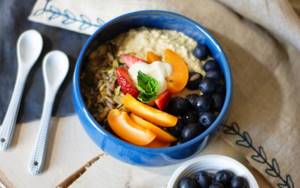
We have calculated the calories for the ingredients listed above, so if you add anything else, the numbers will of course be different.
One 220g serving contains: 450 calories | 14 g protein | 9.7 g fat | 74 g carbohydrates
Lunch
1 medium banana + nuts 50 g + natural yogurt 2.5% fat 200 ml.
One serving contains: 521 kcal | 16 g protein | 33.5 g fat | 10.8 g carbohydrates
Meatballs with cheese

Ingredients for two servings:
- 250 g minced pork and beef
- 1 medium onion
- 40 g large oat flakes
- 50 g of any hard cheese
- salt, pepper, spices to taste
- sunflower oil
Turn the oven on to 200 degrees and let it heat up. Wash, peel and chop the onion as finely as you can. Pour boiling water over the oatmeal so that it covers 1 cm. Cut the cheese into cubes about 1x2 cm. Place the minced meat in a deep bowl, add salt, pepper and, if you want, add spices (basil, oregano, dill, cumin, etc.), onion and squeezed water flakes. Mix the minced meat thoroughly with your hands.
Place the frying pan over high heat and grease it with oil. When the oil is hot, wet your hands with cold water and roll the minced meat into a ball. Flatten it slightly and place a block of cheese in the center, then remember your golden childhood and roll it into a neat sphere, which you then need to put on a hot, oiled frying pan and fry until golden brown on all sides. Process all the minced meat in this way, and then put the fried meatballs in a heat-resistant form, cover with foil or a lid and place in the oven for 10-12 minutes.
One serving (200 g) contains: 593.4 kcal | 40 g protein | 40 g fat | 14 g carbohydrates
Rice with vegetables
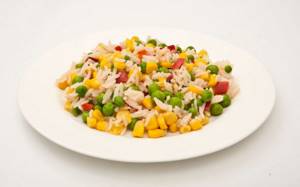
Ingredients for two servings:
- 1 cup (200g) rice
- 1 medium carrot
- 1 medium onion
- 1 red bell pepper
- 1 clove of garlic
- 80 g frozen green peas
- 80 g canned corn
- 20 g olive oil
- 400 ml boiling water
- salt, pepper, spices to taste
All vegetables need to be washed, carrots, onions and garlic need to be peeled, seeds and membranes removed from the peppers, nothing needs to be done with the peas - let them rest in the freezer for now. Rinse the rice, and if it is in a bag, boil it as directed on the package.
Grate the carrots on a coarse grater, chop the onion and pepper into pieces of a size you like, and crush the garlic with the flat side of a knife and chop it up a little. The crushed garlic should be placed in a preheated and oiled deep frying pan or pan (it is better to have a non-stick bottom). Fry the garlic for 10-15 seconds, and add onions, carrots and bell peppers. Stirring occasionally, fry this whole bunch for 7-9 minutes, then add ice peas to them and, periodically repeating rotational movements with a spoon inside your frying pan, keep the vegetables over medium heat and covered for another 5 minutes.
If you've used bagged rice, you're at the finish line. You need to combine the finished rice with vegetables and simmer over medium heat for 3-5 minutes. And if you are not looking for easy ways, then put the water to boil, and while it is heating up, add dry rice to the vegetables. When the water boils, reduce the heat under the pan to low and pour in enough liquid to cover the rice and vegetables by two fingers. Close the lid and simmer for 15-20 minutes. You need to stir the whole thing and build a “slide” every five minutes, collecting rice from the edges and lifting it from the bottom. Once all the water has been absorbed, turn off the burner, close the lid and let stand for another 5-10 minutes without heating.
One serving (250 g) contains: 478.4 kcal | 10 g protein | 10 g fat | 84 g carbohydrates
Cabbage and cucumber salad
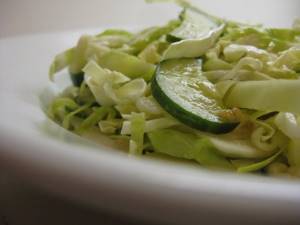
Ingredients for two servings:
- 200 g Chinese cabbage
- 2 medium cucumbers
- 1/2 green apple
- 1 tablespoon olive oil
- salt, pepper, herbs to taste
Wash everything, peel the cucumbers and apple. Roughly chop cucumbers, cabbage and apples, season with oil, salt and pepper. All.
One serving contains: 74.3 kcal | 1.4 g protein | 5.3 g fat | 4.7 g carbohydrates





